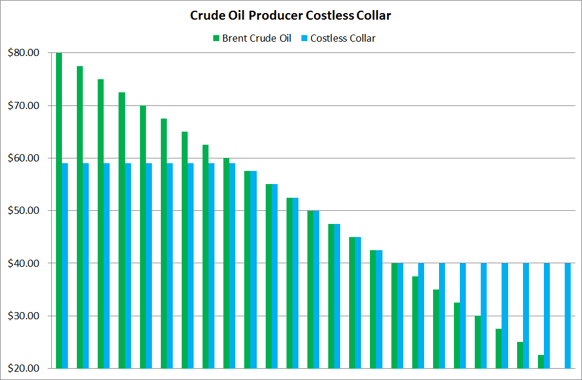The Fundamentals of Oil & Gas Hedging - Costless Collars
This post is the fourth in a series where we are exploring (no pun intended) how oil and gas producers can hedge their exposure to crude oil, natural gas and NGL prices. The first three posts addressed how oil and gas producers can hedge with futures, swaps and put options.
As we noted in the previous post, an option is contract which provides the buyer of the contract the right, but not the obligation, to purchase or sell a specific volume of a specific commodity, or the financial equivalent of said commodity, on or before a specific date or period of time. In addition, we addressed the two primary types of options - call options and put options. A call option provides the buyer of the option with a hedge against higher while a put option provides the buyer of the option with a hedge against lower prices.
While futures, swaps and put options are the preferred hedging strategies of many oil and gas producers, many also utilized a strategy known as a costless collar. While the terminology might sound confusing at first, it’s actually quite simple. A costless collar is the combination of two options. In the case of a producer it is generally the combination of buying a put option (floor) and selling a call option, the combination of which results in both a floor and a ceiling.
As an example, let’s examine how an oil and gas producer can hedge with "producer costless collar" on Brent crude oil, a strategy which will include buying a Brent crude oil put option and selling a Brent crude oil call option. In addition, to make the option costless, the options will be structured so that the premium paid for the put option will be offset by the premium received from selling the call option.
For the sake of this example, let's assume that you are an oil and gas producer looking to hedge your December crude oil production with a Brent crude oil costless collar. Let’s further assume that you need to be hedged against December Brent prices trading below $40/BBL. As such, you decided to buy a $40 December Brent crude oil APO (average price) put option for a premium of $1.50/BBL. In addition, in order to offset the cost of the $1.50 premium associated with the $40 put option, you also sell a $59 December Brent crude oil APO (average price) call option for a premium of $1.50/BBL
The combination of these two options provides you with a December Brent $40/$59 producer costless collar, which equates to a $40 floor and a $59 ceiling. As such, if Brent crude oil prices during December average less than $40/BBL then you will incur a hedging gain. Conversely, if Brent crude oil prices during December average more than $59/BBL then you will incur a hedging loss. If the price is between $40 and $59 then you will incur neither a hedging gain nor loss.
How will the $40/$59 costless collar will perform if Brent crude oil prices during the month of December average less $40/BBL and more than $59/BBL?

Let's first look at a scenario where the average settlement price for the prompt Brent crude oil futures, during the month of December, is $35.00/BBL. In this case, the price you receive at the wellhead for your December crude oil production will be approximately $35.00/BBL. However, because you are hedged with the $40 put option, you would receive a hedging gain of $5/BBL. As such, the net price you receive for your December production, excluding the basis differential, gathering and transportation fees) will be $40/BBL.
Now let’s examine a scenario where the average settlement price for the prompt Brent crude oil futures, during the month of December, is $70.00/BBL. In this case, the price you receive at the wellhead for your December crude oil production will be approximately $70.00/BBL. However, because you sold the $59 call option as part of your costless collar, you would have a hedging loss of $11 on the call option. As such, the net price you receive for your December production, excluding the basis differential, gathering and transportation fees) will be $59/BBL.
As previously mentioned, if the average settlement price for the prompt Brent crude oil futures, during the month of December, is between $40 and $59 you will not incur a hedging gain or loss. For example, if the average settlement price for the month is $50.00, the net price you receive for your December production will be approximately $50/BBL.
As this example indicates, costless collars can be an effective hedging strategy for oil and gas producers. However, because one "leg" of the strategy involves selling (shorting) a call option, you need to fully understand the potential risks of selling a call option before you hedging with a costless collar, something many market participants have learned the hard way. For example, when prices spiked in 2008 many oil and gas producers who had hedged with costless collars were subjected to margin calls which were difficult to meet, as their borrowing bases did not yet reflect the higher price environment.
This post is the fourth in a series on hedging crude oil and natural gas production. The previous posts can be viewed via the following links:
The Fundamentals of Oil & Gas Hedging - Futures
